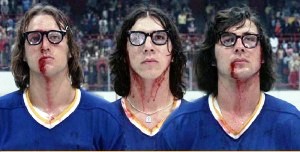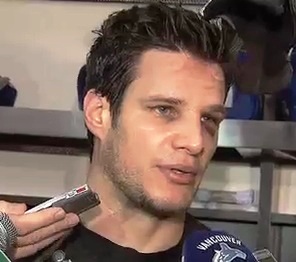The Penalty Box– It began with the New Jersey Devils submitting a dubious starting lineup at the Garden last Monday. When the New York Rangers countered by assigning Stu Bickel to take the opening face off, it was on.

Stu Bickel never takes the opening faceoff.
Everyone knew what was coming before it happened. The teams knew it, the crowd knew it, and the announcers knew it. When the ref dropped the puck at center ice, Bickel and Devil Ryan Carter didn’t even bother facing off. They just went at each other. In no time, four more players were pairing of to trade blows: Rangers Brandon Prust and Michael Rupp tangled with Devils Cam Janssen and Eric Boulton.
The fans loved it. They often do. But the question lingers: Is fighting good for the NHL’s business?
The NHL is by far and away the least popular of the four major team sports in the United States. The NFL reigns supreme. Then comes Major League Baseball, the fading starlette of the bunch. Once upon a time, the NBA and NHL were neck-and-neck for third. But basketball moved on long ago, leaving hockey behind in a distant fourth place. Indeed, it may soon drop to fifth behind another import, soccer.
Many commentators believe the endemic violence keeps people away and impedes the NHL’s business growth. But I wonder if that’s actually true. In an era when grotesque brutality has helped make Mixed Martial Arts the fastest growing sport in America, and violence is crucial to explaining football’s unrivaled popularity, is fighting really why the NHL continues to languish, barely able to get its games shown on major networks?

Clearly, the NHL doesn’t think so. For example, just last year when Air Canada CEO Calin Rovinescu was disgusted by a sickening fight between the Boston and Montreal, he sent a private memo to the league. Clean up the sport, he said, or Air Canada will consider withdrawing its sponsorship.
In response, the NHL went public with Rovinescu’s memo, chided him for meddling in the league’s private affairs, and essentially told him to take his business elsewhere if he didn’t like it.
Air Canada backed down.
And it’s not just the league. Many players also support the violence. When Dr. Rajendra Kale of the Canadian Medical Association Journal called upon the NHL to stop the violence, Vancouver Canucks defenseman Kevin Bieksa responded:
“I think fighting is part of the game. [Kale’s] a doctor and we’re making him a little bit of money on the side. He gets to fix us up. We’ll let him do his job, and he should let us do our job.”
There are actually numerous reason why most American sports fans utterly ignore hockey: few of them grow up playing the game; competition from the other three established team sports is difficult to overcome; the lack of media exposure limits growth; and indeed, most Americans don’t even really understand how this Canadian game is played.

Personally, I’d like to do away with the fighting. But I think we’re kidding ourselves if we think violence is the reason why the NHL is an also-ran in the U.S. spectator sports market.
Indeed, the United States has one of the most martial and violent cultures in the developed world. Thus, it may very well be that the NHL’s position at the bottom of the sports heap comes despite the game’s violence, not because of it.
Cheesy Bruin is at the very top of MtM tomorrow.

